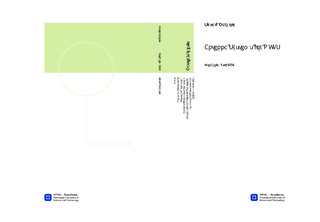| dc.description.abstract | NTNU is aiming to build and launch a small student satellite compliant with thedouble CubeSat standard, by 2014. The NTNU Test Satellite (NUTS) will carrytwo radio tranceivers and a beacon transmitter, all located in the VHF and UHFamateur bands. The goal of this thesis was to build the whole antenna systems forthe spacecraft.Turnstile antennas were chosen both for UHF and VHF, since they yield thehighest received signal strength on ground throughout the whole pass of the satel-lite. In order to reach this conclusion, a study of how the choice of spacecraftantennas dynamically influence the link margin was carried out. Furthermore, theantennas was made by measuring tape, and is to be wrapped around the satelliteuntil deployment. This is for the satellite to be within the size constraints of adouble CubeSat during launch. The measuring tape will be tightened to the satel-lites body by nylon thread, which will be burnt off by Nichrome-wire to release themeasuring tape when the satellite is in-orbit. The measuring tape is mounted inbetween two circuit boards constituting the internal part of the antenna module.The feeding network is encapsulated by these two circuit boards. The module ismade such that the antenna complies with the CubeSat standard, and such that itcan be integrated with other modules on-board the satellite, such as the camera.Feeding the antennas turned out more difficult than first anticipated. Whereasconventional feeding networks for turnstile antennas typically comprises baluns andarrangements of coaxial cable comparable to the wavelength, such solutions are notfeasible within the satellite due to size constraints. As a result a lumped feedingnetwork was designed, that could be mounted on one of the circuit boards.Because of the many reactive components in the feeding network, it becamenecessary to determine how deviations in component values affect the performanceof the circuit. Statistical simulations was performed, and the deviations may causean unbalance between the amplitudes and phases of the outputs. But this resultsin less than half a dB additional losses in the link budget.A refinement of electromagnetic antenna simulations from previous work wasalso carried out. With this, the performance of the antennas was verified, andtheir lengths were optimized to yield the best possible match. The VHF antenna isnear-ideal both in terms of pattern and matching. The pattern of the UHF antennais somewhat distorted, but it is still considered to be the best suited antenna ofthose considered. The matching of the UHF antenna could have been better, butis considered acceptable. Moreover, the mutual coupling between the VHF andUHF antennas were studied, with the conclusion that the antennas may very wellco-exist on-board the satellite.Finally, both the feeding network and the VHF antenna were successfully builtand tested. The feeding network had an insertion loss of less than 2 dB, whereas thepattern of the antenna was measured to be near-ideal. Unfortunately, a fault hasoccurred on the UHF feeding network, which also prohibits the pattern for the UHFantenna to be measured. Nonetheless, all the parts constituting it has been built,and all the necessary simulations are done. Previous and future troubleshooting ofthe feeding network is also discussed. | nb_NO |

